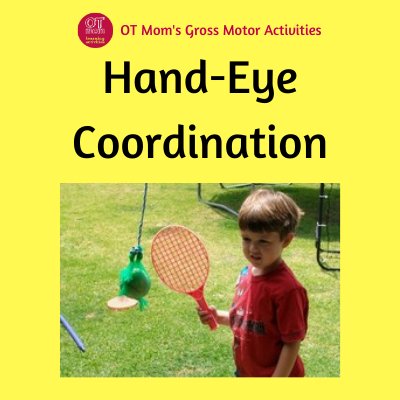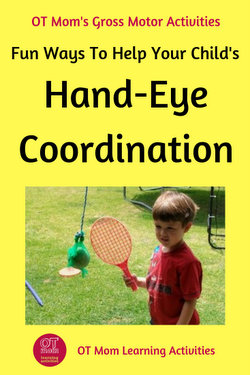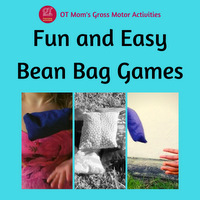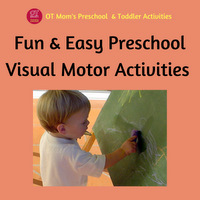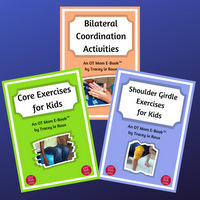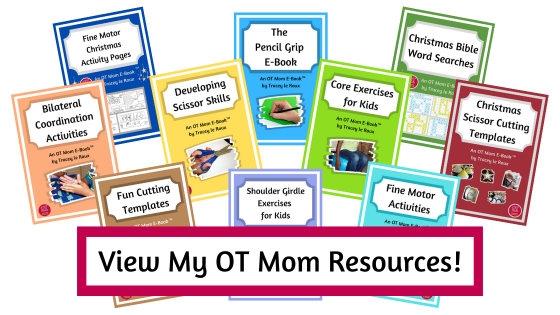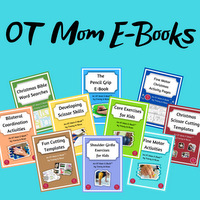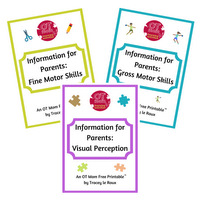- Home Page
- Coordination Skills for Kids
- Hand Eye Coordination Activities
Hand Eye Coordination Activities
Hand eye coordination enables the eyes to guide the hands in accurate movement.
This article will help you understand more about what eye-hand coordination is, why it is such an important skill, and will give you some simple activities you can do at home with your child.
I sometimes link to products (#Ad) that are similar to those I use and love. If you do purchase something through my links, I will receive a small commission that helps support my site - thank you!
Why Is Hand-Eye Coordination Important?
Good eye-hand coordination can help your child in so many different areas of life.
Here are just a few:
- Sports:
Hand eye coordination can help your child to catch a ball, and to hit a ball with a bat, and then graduate to more challenging sporting demands. - Handwriting:
Visual-motor integration, which is a vital base for handwriting, grows out of eye-hand coordination. The eyes need to guide the hand in forming the letters and making sure they stay within the lines. - Reading:
Eye tracking skills, which are vital for reading, can be developed through the games and activities used for hand eye coordination. - Life Skills:
Young children use this skill in learning to stack towers, build with lego etc. We also need our eyes to guide our hands when we tie shoelaces and when we frost cakes!
Activities To Develop Hand Eye Coordination
These activities and games are ideal for toddlers and preschoolers to help them develop eye hand coordination skills.
1) Rolling A Ball
This activity is lovely for toddlers and young preschoolers.
- Have your child sit with legs apart, as shown, and you roll the ball to your child.
- Your child needs to try and stop the ball before it hits the body. This means your child will be watching the ball carefully and then coordinating the hands to stop the ball at just the right time.
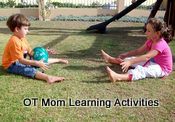 Rolling a ball
Rolling a ball2) Object Relays
This is a fun indoor or outdoor game and the whole family can take part!
You can use different objects, depending on the theme and occasion (holiday themes and birthday parties are great for this game)!
Works on bilateral as well as hand eye coordination.
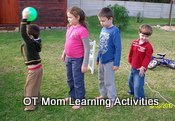 Object relay
Object relay- The kids stand in a line and pass the ball/object to the child behind them.
- Do it overhead, then between the legs.
- Encourage the kids to use both hands together.
- Make it more fun by having a bucket of objects at the front that have to be transferred to an empty bucket at the back.
- You can do this in fireman relay style, where everyone keeps their place, or have the last kid run to the front after placing the object in the bucket at the back, that way they all get a turn to be in front.
3) Passing and Gentle Tossing
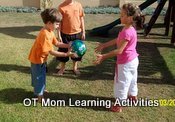 Passing a ball
Passing a ball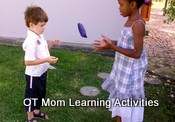 Gentle tossing
Gentle tossingIt takes a lot of concentration for a toddler or a preschooler to pass or toss something carefully with both hands!
- Play a variety of circle or line games, like the relays above, where balls or beanbags are carefully passed from one player to another.
- Then upgrade to gentle tossing.
- Have the kids move one step away from each other and then gently toss the ball or beanbag to each other.
For toddlers and preschoolers, I also have some easy visual motor activities that can help improve hand eye coordination skills.
Eye-Hand Activities for Older Kids
1) Ball-Wall Toss
Once your child has had lots of practice catching and hitting a suspended ball, you can try a ball-wall toss.
Find a nice stretch of high wall with no windows or breakable objects nearby. Smoother walls are better than bumpy ones.
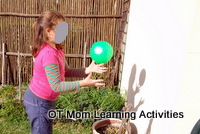 Tossing a ball against a wall
Tossing a ball against a wall- Ask your child to toss the ball against a wall and catch it again.
- You will need to experiment a bit to find the most effective distance from the wall – it depends on the type of ball, and how forcefully your child throws it, but encourage your child to start with a gentle toss!
- See how many your child can catch before missing and keep a running record of the best tally. Encourage your child to better the score each time!
2) Toss and Catch
- Tossing a beanbag or ball into the air and catching again is a good hand-eye coordination exercise.
- If your child tends to throw haphazardly, have your child stand in a hoop or mark a circle to stand in - this can help kids throw more carefully.
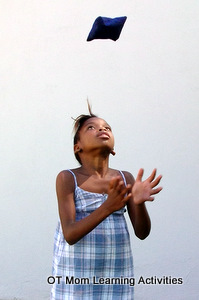 Toss and catch
Toss and catch Standing in a hoop
Standing in a hoop3) Threading and Lacing
Threading beads and completing a lacing card, are fine motor activities that have a big eye-hand coordination component. Use chunky beads and laces if your child struggles, or have your child thread beads onto a pipe cleaner/chenille stick for extra stability.
 Eyes focusing on the hands
Eyes focusing on the hands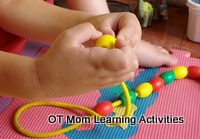 Threading beads
Threading beadsDaddiLifeForce has a really cute idea for a bead tree that your child may enjoy!
Thank you for visiting my site! I hope you found these activity ideas helpful!
Why not sign up for my occasional newsletter to keep in touch with new activity ideas?
- Home Page
- Coordination Skills for Kids
- Hand Eye Coordination Activities
Share this page to help others!
Try a Thingy Flip for Hand-Eye Coordination!
The Thingy Flip is an awesome toy/game that has been developed to improve eye-hand coordination skills. It can also help improve focus and concentration, and can have a great impact on your child's cricket, baseball, tennis or softball skills.
The Thingy Flip can be used to teach a young child how to toss and catch, but is equally helpful for teenagers and adults who want to perfect their hand-eye coordination.
An Australian creation, it can be shipped to many different locations. A great addition to any sports program, training program, or even as a homeschool break.
It's addictive once you start, as you try to improve your record each time!
Check out the Thingy Flip in action and get hooked!
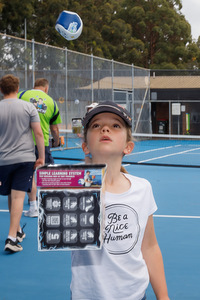
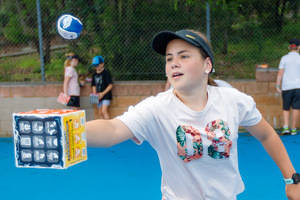 The Thingy Flip In Action!
The Thingy Flip In Action!Related Pages
Didn't find what you were looking for? Try a search of my site!
